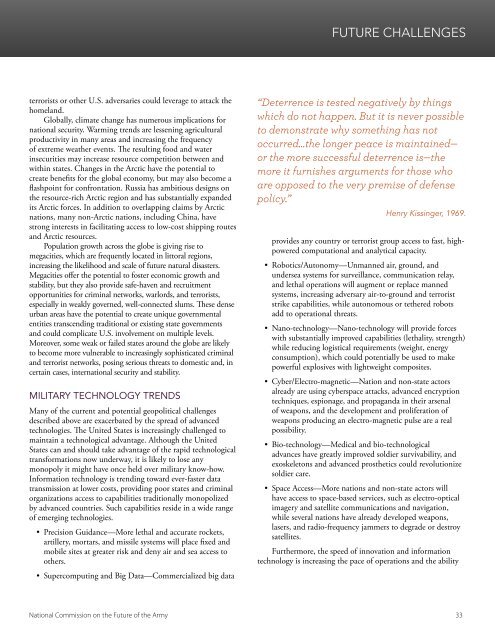THE FUTURE OF THE ARMY
Futurearmy
Futurearmy
You also want an ePaper? Increase the reach of your titles
YUMPU automatically turns print PDFs into web optimized ePapers that Google loves.
<strong>FUTURE</strong> CHALLENGES<br />
terrorists or other U.S. adversaries could leverage to attack the<br />
homeland.<br />
Globally, climate change has numerous implications for<br />
national security. Warming trends are lessening agricultural<br />
productivity in many areas and increasing the frequency<br />
of extreme weather events. The resulting food and water<br />
insecurities may increase resource competition between and<br />
within states. Changes in the Arctic have the potential to<br />
create benefits for the global economy, but may also become a<br />
flashpoint for confrontation. Russia has ambitious designs on<br />
the resource-rich Arctic region and has substantially expanded<br />
its Arctic forces. In addition to overlapping claims by Arctic<br />
nations, many non-Arctic nations, including China, have<br />
strong interests in facilitating access to low-cost shipping routes<br />
and Arctic resources.<br />
Population growth across the globe is giving rise to<br />
megacities, which are frequently located in littoral regions,<br />
increasing the likelihood and scale of future natural disasters.<br />
Megacities offer the potential to foster economic growth and<br />
stability, but they also provide safe-haven and recruitment<br />
opportunities for criminal networks, warlords, and terrorists,<br />
especially in weakly governed, well-connected slums. These dense<br />
urban areas have the potential to create unique governmental<br />
entities transcending traditional or existing state governments<br />
and could complicate U.S. involvement on multiple levels.<br />
Moreover, some weak or failed states around the globe are likely<br />
to become more vulnerable to increasingly sophisticated criminal<br />
and terrorist networks, posing serious threats to domestic and, in<br />
certain cases, international security and stability.<br />
MILITARY TECHNOLOGY TRENDS<br />
Many of the current and potential geopolitical challenges<br />
described above are exacerbated by the spread of advanced<br />
technologies. The United States is increasingly challenged to<br />
maintain a technological advantage. Although the United<br />
States can and should take advantage of the rapid technological<br />
transformations now underway, it is likely to lose any<br />
monopoly it might have once held over military know-how.<br />
Information technology is trending toward ever-faster data<br />
transmission at lower costs, providing poor states and criminal<br />
organizations access to capabilities traditionally monopolized<br />
by advanced countries. Such capabilities reside in a wide range<br />
of emerging technologies.<br />
• Precision Guidance—More lethal and accurate rockets,<br />
artillery, mortars, and missile systems will place fixed and<br />
mobile sites at greater risk and deny air and sea access to<br />
others.<br />
• Supercomputing and Big Data—Commercialized big data<br />
“Deterrence is tested negatively by things<br />
which do not happen. But it is never possible<br />
to demonstrate why something has not<br />
occurred…the longer peace is maintained—<br />
or the more successful deterrence is—the<br />
more it furnishes arguments for those who<br />
are opposed to the very premise of defense<br />
policy.”<br />
Henry Kissinger, 1969.<br />
provides any country or terrorist group access to fast, highpowered<br />
computational and analytical capacity.<br />
• Robotics/Autonomy—Unmanned air, ground, and<br />
undersea systems for surveillance, communication relay,<br />
and lethal operations will augment or replace manned<br />
systems, increasing adversary air-to-ground and terrorist<br />
strike capabilities, while autonomous or tethered robots<br />
add to operational threats.<br />
• Nano-technology—Nano-technology will provide forces<br />
with substantially improved capabilities (lethality, strength)<br />
while reducing logistical requirements (weight, energy<br />
consumption), which could potentially be used to make<br />
powerful explosives with lightweight composites.<br />
• Cyber/Electro-magnetic—Nation and non-state actors<br />
already are using cyberspace attacks, advanced encryption<br />
techniques, espionage, and propaganda in their arsenal<br />
of weapons, and the development and proliferation of<br />
weapons producing an electro-magnetic pulse are a real<br />
possibility.<br />
• Bio-technology—Medical and bio-technological<br />
advances have greatly improved soldier survivability, and<br />
exoskeletons and advanced prosthetics could revolutionize<br />
soldier care.<br />
• Space Access—More nations and non-state actors will<br />
have access to space-based services, such as electro-optical<br />
imagery and satellite communications and navigation,<br />
while several nations have already developed weapons,<br />
lasers, and radio-frequency jammers to degrade or destroy<br />
satellites.<br />
Furthermore, the speed of innovation and information<br />
technology is increasing the pace of operations and the ability<br />
National Commission on the Future of the Army 33


